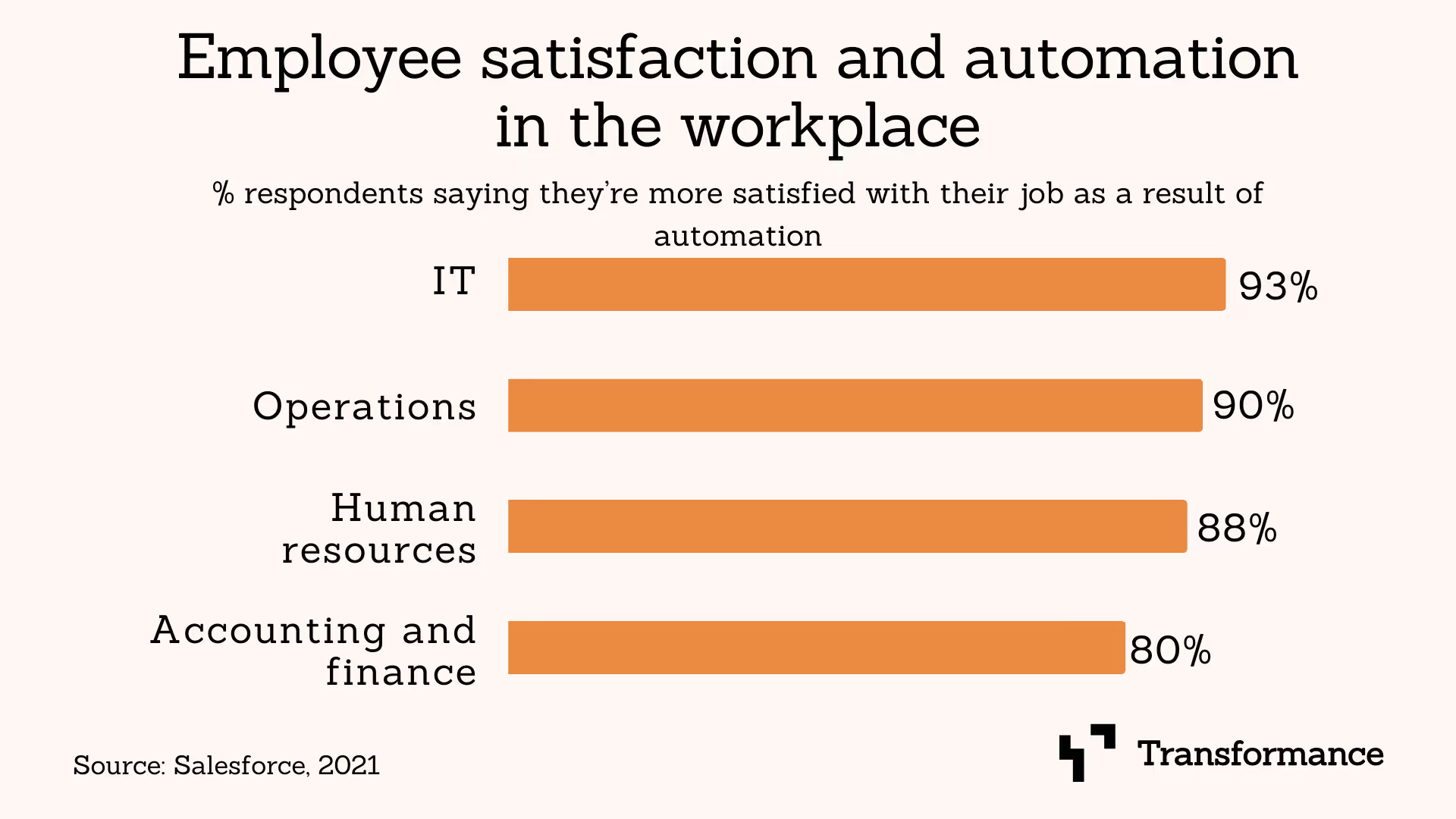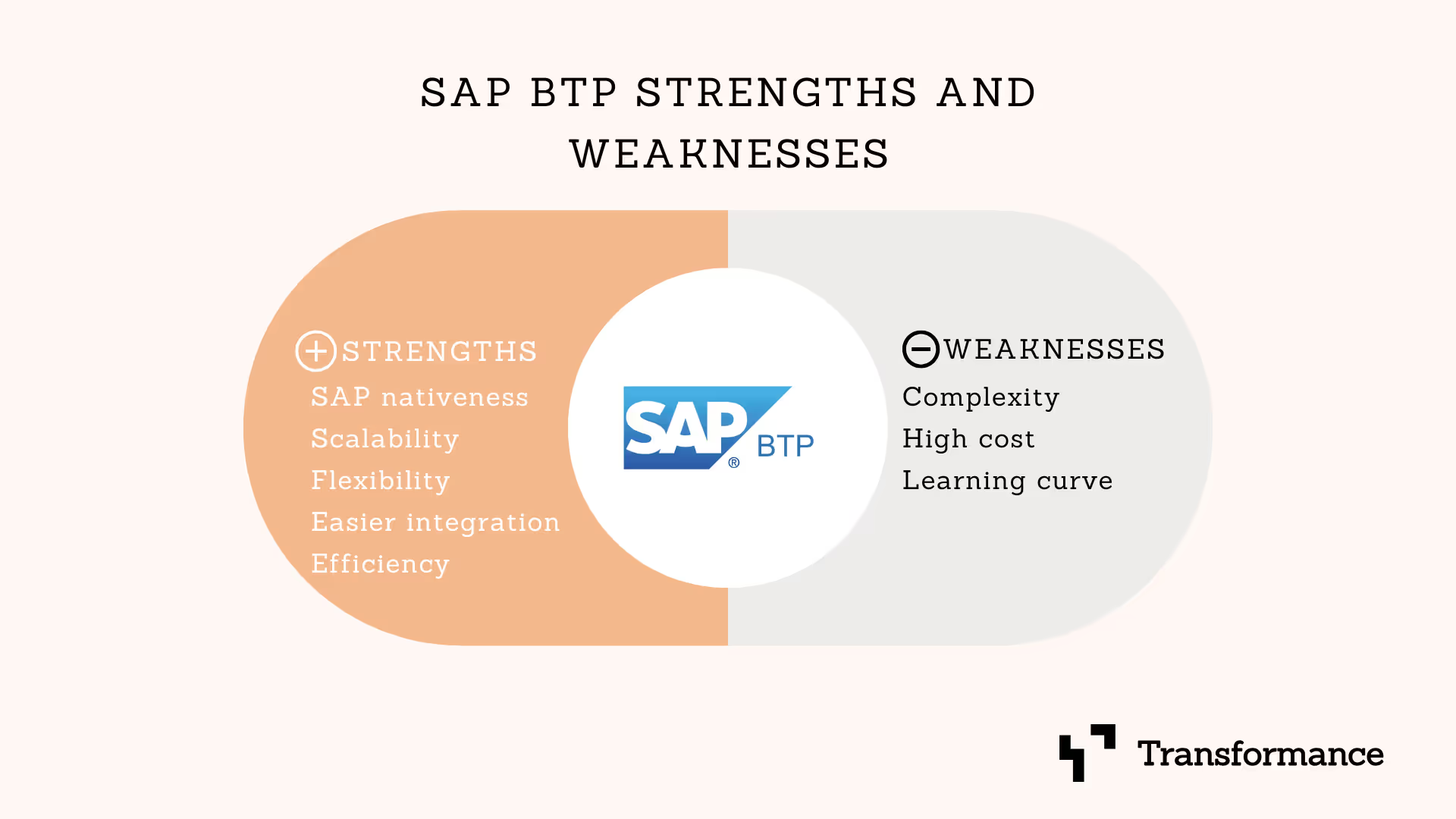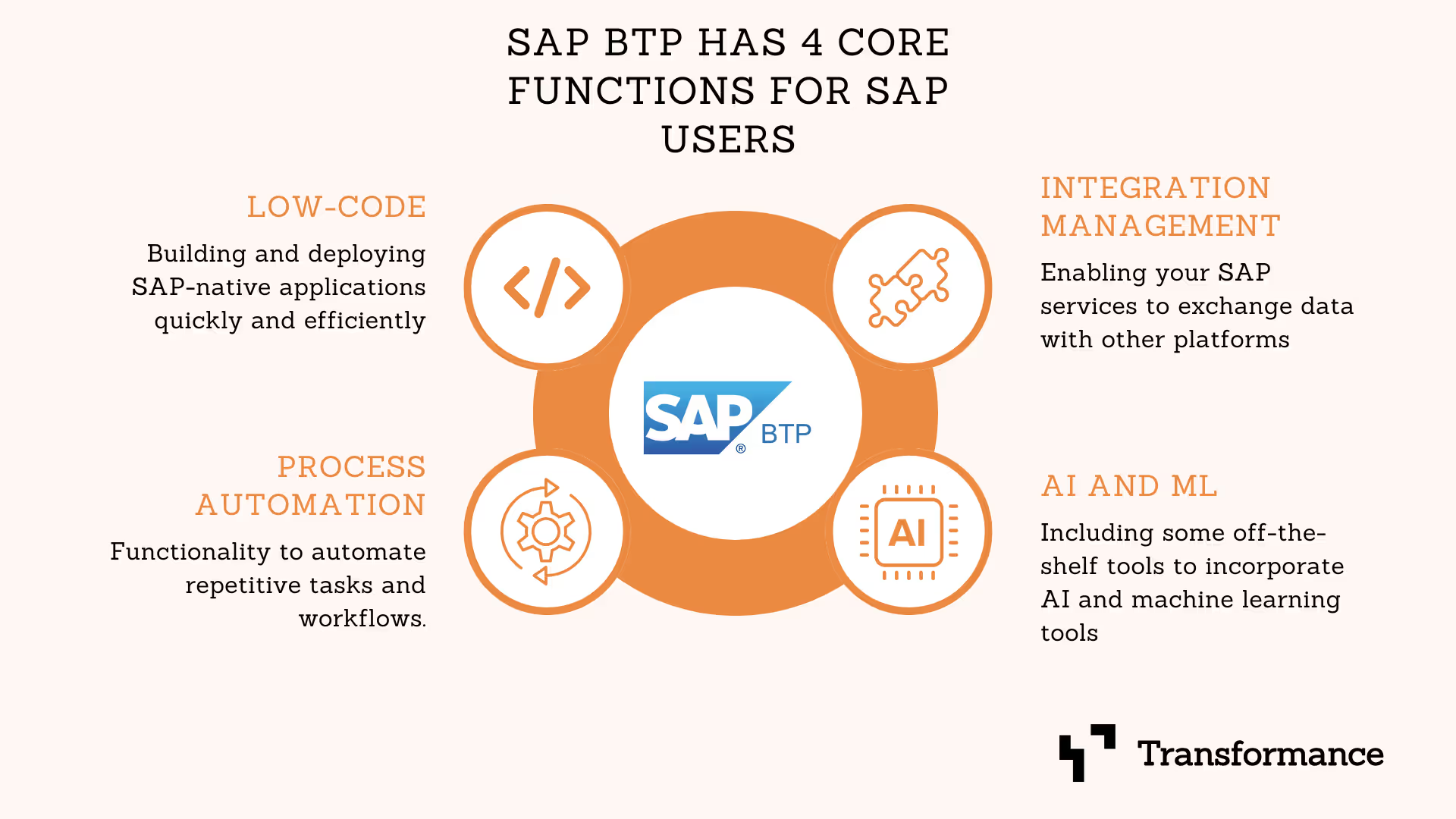What is SAP BTP and How It Works
SAP BTP is a cloud-based platform-as-a-service that brings together tools for building applications, automating processes, integrating systems, analysing data and embedding AI. It allows teams to create side-by-side extensions to the ERP system without touching S/4HANA core—and it runs on hyperscalers like AWS, Azure, Google Cloud, Alibaba Cloud, and SAP-managed regions. As SAP positions BTP as a foundational part of its “Clean Core” strategy, adoption is now widespread: according to ASUG, 55 percent of SAP customers use BTP, and 73 percent of those use it during their S/4HANA migration.
Learn more in our article on the power of automation in SAP and four use cases.

BTP Architecture and Core Components
SAP BTP is organised around several key functional areas:
SAP BTP Integration Suite
Includes Cloud Integration, API Management, Open Connectors (170+ SaaS adapters), Event Mesh and Integration Advisor for ML-based EDI mappings. Used by 69 percent of users as their core BTP capability.
Application Development and Extensibility
- SAP Build (Apps, Process Automation, Work Zone) for low-code UI, forms and workflows
- CAP + Cloud Foundry for pro-code Java or Node.js microservices using CDS models
- ABAP Environment (Steampunk) for side-by-side ABAP extensions
- Kyma Runtime for managed Kubernetes workloads and event-driven services
Data and Analytics
- SAP HANA Cloud for real-time data processing
- SAP Datasphere for a unified business data fabric
- SAP Analytics Cloud (SAC), used by 60 percent of organizations after migrating to S/4HANA for dashboards and forecasting
AI and Automation
- AI Core and AI Launchpad to manage model lifecycles securely
- AI Business Services for invoice capture, document extraction, product recognition
- Joule, SAP’s embedded GenAI copilot to help build workflows and UIs
Security, Identity and DevOps
- Identity Authentication Service (IAS), XSUAA, Transport Management, and CI/CD pipelines with full role-based access and governance
Integration of SAP and Non-SAP Applications via BTP
Three main integration patterns:
API-first pattern
Expose SAP data via OData/REST through API Management with portal, rate limiting, security and reuse.
Event-based pattern
Event Mesh streams S/4HANA events asynchronously to Kyma or functions for real-time triggers.
B2B/EDI onboarding
Integration Advisor reduces partner mapping time; onboarding now moves twice as fast.
SAP Cloud Connector and Private Link provide secure tunnels to on-premise systems without exposing firewalls or direct ports, enabling hybrid scenarios with controlled traffic and low latency.
Explore our guide on 6 steps to using business process automation.

Strengths of SAP BTP in 2025
- Supports clean-core strategy: Extensions live outside the ERP, so S/4 upgrades stay safe
- Multi-cloud deployment: Choose region or provider to meet compliance, latency or residency needs
- Enterprise-grade integration: 69 percent of users rely on it for core integration—ROI estimates exceed 300 percent
- Governed AI adoption: Prebuilt AI services and GenAI through Joule let you add intelligence while keeping data within customer control
- Prebuilt content and marketplace velocity: Templates, connectors and flows reduce build time significantly and accelerate delivery
For hands-on advice, read how to choose the best automation software for your finance team.
Weaknesses and Challenges of SAP BTP
- Credit under-utilisation: SAP estimates $600M per year, or nearly 25 percent of credits go unused due to lack of consumption strategy
- High skill requirements: CAP, Kyma and ABAP Cloud demand specialist knowledge and disciplined governance
- Pricing complexity: Monitoring memory hours, capacity units, message credits and task counts is difficult to manage
- Fragmented tooling and user experiences: Teams must switch among BTP Cockpit, Cloud ALM, Business Application Studio and command-line tools
- Latency in hybrid scenarios: Cloud applications talking sync to on-prem systems can experience slow response times without caching or design patterns that buffer requests
Want something simpler? Transformance AI eliminates credit waste and infrastructure overhead. Book a free consultation to learn more.

App Development on SAP BTP Platforms
SAP BTP supports different personas with tailored tools:
These components integrate via CI/CD pipelines and transport management services to maintain governance and a production-grade deployment pipeline.
See our breakdown of the best SAP ERP automation tools in 2025 for comparisons.
Facts and Figures About SAP BTP in 2025
- 55 percent of SAP customers use BTP, and 73 percent of them integrate it during S/4HANA transformation
- Integration is the most cited use case (69 percent), but automation and analytics are rising fast
- 60 percent of companies use SAP Analytics Cloud; usage rises to 73 percent after S/4 migration
- 54 percent of IT leaders consider Datasphere critical for enabling generative AI programs
- Around $600M in BTP credits goes unused every year across the customer base
SAP BTP Alternatives and FAQs About SAP BTP
Why many teams choose Transformance AI
Transformance AI builds SAP-compatible applications using AI-native agents. It eliminates the need for Kubernetes, server provisioning or credit tracking. You pay for working software, not cloud runtime.
- AI agents generate UIs, workflows, documentation and test scripts automatically
- Runs in your infrastructure—no customer data stored
- Supports ABAP or REST outputs to deploy inside S/4 or next to BTP services
- Live in 2–5 weeks; case study: a logistics company automated 90 percent of claims, saving over €60K per year
Learn more in our article on 11 tips for choosing the right AI no-code software.
Frequently Asked Questions about SAP BTP
How does SAP BTP integrate SAP and non-SAP systems?
Integration Suite provides tools like Cloud Integration, Open Connectors, Event Mesh and API Management to securely connect ERP to external apps like Salesforce or ServiceNow.
What are the core components of SAP BTP?
Key areas include Integration Suite, SAP Build, Cloud Foundry, ABAP Environment, Kyma, Datasphere, HANA Cloud, AI Core and Joule.
How does SAP BTP support AI in business processes?
AI Core manages model training and deployment. AI Business Services offer plug-and-play models for documents and forecasting. Joule supports low-code generation of workflows using GenAI.
Why is multi-cloud support important in BTP?
You can choose where to deploy—region, cloud provider, or data residency requirement—while still using SAP-managed tooling and governance.
How does BTP help turn data into strategy?
SAP Datasphere and SAP Analytics Cloud unify structured data from across sources and deliver real-time dashboards that can trigger automated workflows.
—
Want to know which workloads fit best on Transformance or BTP? Request a demo now and get a tailored solution map in 30 minutes or less.






